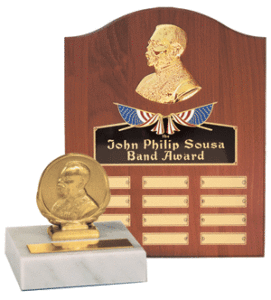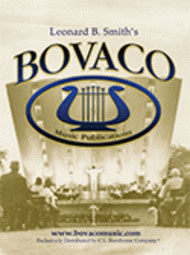Frequently Asked Questions (FAQ)
What is the John Philip Sousa Award for band students?
The John Philip Sousa Award is an optional award a high school band director may award to one of his students. It is restricted to one per school per year (or two in the rare event of a tie). The award recognizes superior musicianship, dependability, loyalty, and cooperation. Band directors may order the award from The Instrumentalist magazine (200 Northfield, Northfield, IL 60093 … phone 847-446-8550 or visit their website).
For a list of previous John Philip Sousa award winners, visit http://www.sousawinners.com.
The Semper Fidelis Award may also be awarded to high school band students. Band directors that wish to nominate a student (a junior or senior who holds a “first chair” position) should contact the local U.S. Marine recruiter serving their high school. (Thanks to Sgt. Michael J. Bess for this information!)

Did Sousa write "76 Trombones"?
No. It was written by Meredith Willson for his famous musical “The Music Man”, which was a hit both on Broadway and as a 1962 musical motion picture starring Robert Preston and Shirley Jones.
What is not widely known is that Meredith Willson actually performed with Sousa’s band as a flute/piccolo player for several years. This band experience and small-town Iowa roots inspired him to write the musical.
What's the name of that march that goes, "Oh, the monkey wrapped its tail around the flagpole..."?
I don’t know why this is one of the most popular questions I get asked, but it is! The march these words were concocted for is not by Sousa at all. They go to E. E. Bagley’s “National Emblem” march, probably the most famous non-Sousa patriotic march. I don’t know the origin of the words, but I’m relatively sure that Mr. Bagley did not write them! Another interesting fact about National Emblem: the melody first strain is based on “The Star Spangled Banner.”
Did Sousa write "Hail to the Chief" (played for the President of the United States)?
No. As far as the Library of Congress can ascertain, the first time “Hail to the Chief” was associated with a president was in 1815. An old account tells about its being played in Boston on Feb. 22 that year at a joint celebration of Washington’s birthday and the end of the war of 1812. The first documented performance for the president was July 4, 1828 when the Marine Band played it for John Quincy Adams at the groundbreaking of the C&O Canal (thanks to Capt. Frank Byrne of the U.S. Marine Band for this info).
James Sanderson, an Englishman, wrote the music as a part of his work setting a portion of the poem by Sir Walter Scott, “The Lady of the Lake,” to music. That was around 1810. The music first appeared in the United States around 1812.
President Chester A. Arthur asked Sousa to compose a replacement for it. Sousa responded with both the “Presidential Polonaise” and his personal favorite march, “Semper Fidelis”. Arthur didn’t live to hear Semper Fi, and neither piece was able to oust “Hail to the Chief”. Semper Fidelis went on to become the official march of the Marine Corps.
Where can I buy band arrangements of lesser-known Sousa marches?
 The Bovaco Catalog, originally founded by Leonard B. Smith, carries original editions of most Sousa marches among over 2000 other outstanding and hard-to-find vintage band arrangements. Download their catalog from bovacomusic.com or purchase music online from Sheet Music Plus.
The Bovaco Catalog, originally founded by Leonard B. Smith, carries original editions of most Sousa marches among over 2000 other outstanding and hard-to-find vintage band arrangements. Download their catalog from bovacomusic.com or purchase music online from Sheet Music Plus.
Is "The Stars and Stripes Forever" the official march of the U.S.?
Yes! Click here to view Title 36, Section 10, Paragraph 188 of the United States Code, designating “The Stars and Stripes Forever” as the official march of the United States.
There are stories in my family about a relative that played with Sousa's Band. Why is my relative not listed in the band roster on your page?
The Sousa Band roster included on this site is reproduced from Appendix B of Kenneth Berger’s book “The March King and his Band”. In his book, Mr. Berger cites many difficulties in creating a comprehensive listing of all the musicians who played in Sousa’s Band. It excludes members of his U.S. Marine Band (1880-1892) and members of his “Jackies” band at the U.S. Great Lakes Naval Academy during World War I. It also does not include the many local musicians who were allowed the honor of “sitting in” with the Sousa Band during tour performances. The listing is neither official nor comprehensive, but it is the best listing known to me.
I heard a story that Sousa was really an immigrant named John Philipso but because his steamer trunk was labeled "John Philipso, U.S.A.", he changed his name to SOUSA. Is this true?
Not true. There are several versions still floating around, all based on rumors that he added the U-S-A to his last name out of sheer patriotism. This is, however, false. Sousa’s father was the immigrant, and Sousa (or Souza, or De Sousa) is a well-known Portuguese family name. The story was started by the Sousa Band’s manager as a publicity stunt during one of the band’s European tours, and it still endures nearly 80 years after Sousa’s death.
Didn't PBS do a documentary on Sousa?
Yes. The Corporation for Public Broadcasting’s series “The American Experience” produced an hour-long special entitled “If You Knew Sousa”. It is occasionally re-run on PBS and A&E networks, and should also be available from your local library.

Recent Comments